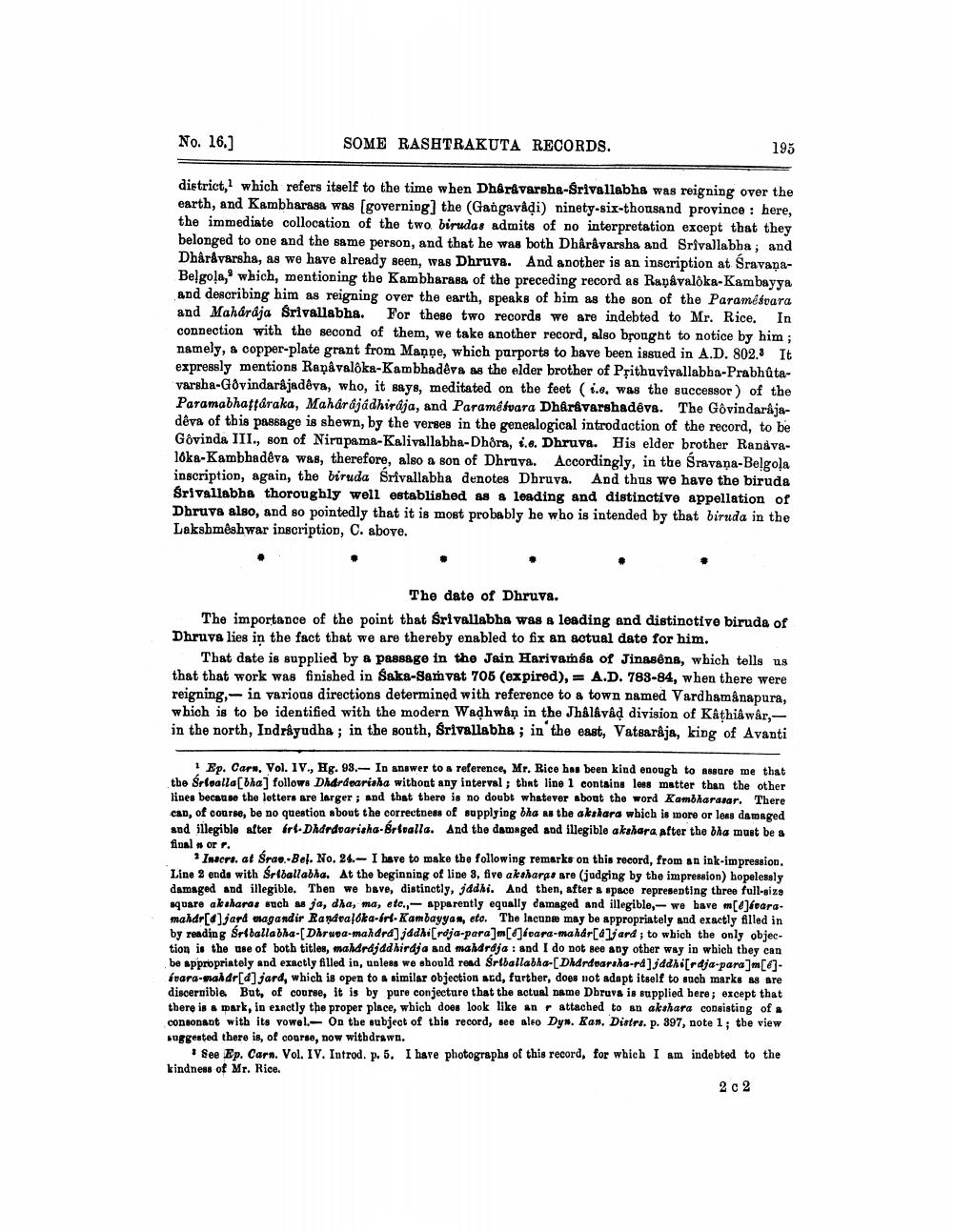________________
No. 16.]
SOME RASHTRAKUTA RECORDS.
195
district, which refers itself to the time when Dhardvarsha-Srivallabha was reigning over the earth, and Kambharasa was (governing) the (Gangavadi) ninety-six-thousand province : here, the immediate collocation of the two birudas admits of no interpretation except that they belonged to one and the same person, and that he was both Dhåråvarsha and Srivallabha; and Dhåråvarsha, as we have already seen, was Dhruve. And another is an inscription at SravanaBelgola,' which, mentioning the Kambharass of the preceding record as Raņávalóka-Kambayya and describing him as reigning over the earth, speaks of him as the son of the Paramé svara and Maharaja Srivallabha. For these two records we are indebted to Mr. Rice. In connection with the second of them, we take another record, also bronght to notice by him ; namely, a copper-plate grant from Mappe, which parports to have been issued in A.D. 802.3 It expressly mentions Ranávalóka-Kambhadêra as the elder brother of Prithuvivallabba-Prabhůtavarsha-Gdvindarajadêva, who, it says, meditated on the feet (1.6. was the successor of the Paramabhaffaraka, Maharajadhiraja, and Paramétvara Dharivarshadêva. The Govindarajadēva of this passage is shewn, by the verses in the genealogical introdaction of the record, to be Govinda III., son of Nirupama-Kalivallabha-Dhora, s.c. Dhruva. His elder brother Randva16ka-Kambhadeva was, therefore, also a son of Dhruva. Accordingly, in the Sravana-Belgola inscription, again, the biruda Srivallabha denotes Dhruva. And thus we have the biruda Srivallabha thoroughly well established as a leading and distinctive appellation of Dhruva also, and so pointedly that it is most probably he who is intended by that biruda in the Lakshmêshwar inscription, C. above.
The date of Dhruva. The importance of the point that Srivallabha was a leading and distinctive biruda of Dhruva lies in the fact that we are thereby enabled to fix an actual date for him.
That date is supplied by a passage in the Jain Harivamss of Jinasena, which tells us that that work was finished in Saka-Samvat 705 (expired), = A.D. 783-84, when there were reigning - in various directions determined with reference to a town named Vardhamanapura, which is to be identified with the modern Wadhwan in the Jhâlâvâd division of Kathiâwâr,in the north, Indrayudha ; in the south, Srivallabhs; in the east, Vatsaraja, king of Avanti
1 Ep. Cars, Vol. IV., Hg. 93.- In answer to a reference, Mr. Rico bas been kind enough to assure me that tbe Srlealla[bha) follows Dhardearisha without any interval; that line 1 contains less matter than the other lines because the letters are larger; and that there is no doubt whatever about the word Kambharasar. There can, of course, be no question about the correctness of supplying bha As the akshara which is more or less damaged and illegible after frf-Dhardvarisha-Brivalla. And the damaged and illegible akahara after the dha must be a final or
Insers, at Srao-Bel. No. 24.- I have to make the following remarks on this record, from an ink-impression. Line 2 ends with Sriballabha. At the beginning of line 3, five aksharps are (judging by the impression) hopelessly damaged and illegible. Then we bave, distinctly, jadbi. And then, after a space representing three full-size Aquare akshanas such as ja, dha, ma, etc., - apparently equally damaged and illegible, we bave m[]foaramahdr[]jari magandir Randraloka-bri-Kambaygas, etc. The lacune may be appropriately and exactly filled in by reading Śreballabha-[ Dhrupa-mahdra] jddhi[roja-para] [boara-mahár[a]jand; to which the only objecby reading once....
lindin e tion is the use of both titles, maldrdjdd hirdja sod mahardja : and I do not see any other way in w
rdia and I do not see any other be appropriately and exactly filled in, unless we should read Srfballabha-[Dhardwarsha-rd]jddhi[rdja-pana]m[q. ivara-nahar[d]jard, which is open to a similar objection acd, further, does not adapt itself to sach marks as are discernible But, of course, it is by pure conjecture that the actual name Dhruva is supplied bere; except that there is a mark, in einctly the proper place, which does look like an attached to an akshara consisting of consonant with its vowel. On the subject of this record, see aleo Dyn. Kan. Dintre. p. 897, note 1; the view suggested there is, of course, now withdrawa.
See Ep. Carn. Vol. IV. Introd. p. 5. I have photographs of this record, for which I am indebted to the kindness of Mr. Rice.
2 c 2
18 which the




